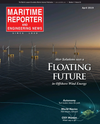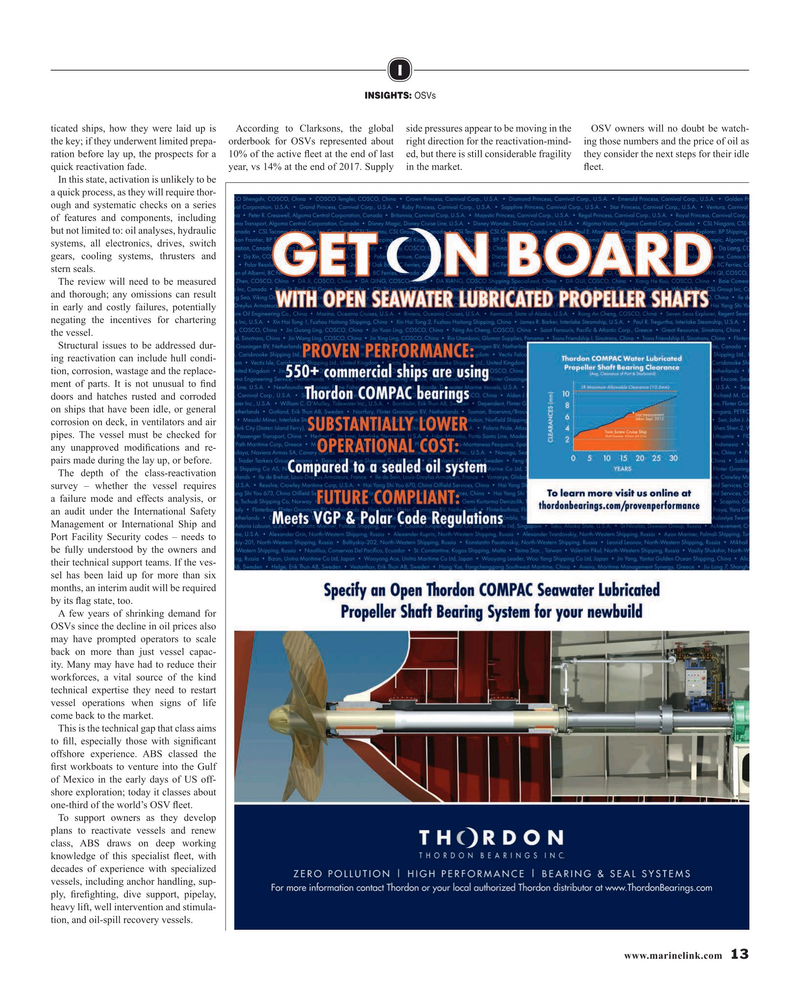
Page 13: of Maritime Reporter Magazine (April 2019)
Navies of the World
Read this page in Pdf, Flash or Html5 edition of April 2019 Maritime Reporter Magazine
I
INSIGHTS: OSVs ticated ships, how they were laid up is According to Clarksons, the global side pressures appear to be moving in the OSV owners will no doubt be watch- the key; if they underwent limited prepa- orderbook for OSVs represented about right direction for the reactivation-mind- ing those numbers and the price of oil as ration before lay up, the prospects for a 10% of the active ? eet at the end of last ed, but there is still considerable fragility they consider the next steps for their idle quick reactivation fade. year, vs 14% at the end of 2017. Supply in the market. ? eet.
In this state, activation is unlikely to be a quick process, as they will require thor- ough and systematic checks on a series of features and components, including but not limited to: oil analyses, hydraulic systems, all electronics, drives, switch gears, cooling systems, thrusters and stern seals.
The review will need to be measured and thorough; any omissions can result in early and costly failures, potentially negating the incentives for chartering the vessel.
Structural issues to be addressed dur- ing reactivation can include hull condi- tion, corrosion, wastage and the replace- ment of parts. It is not unusual to ? nd doors and hatches rusted and corroded on ships that have been idle, or general corrosion on deck, in ventilators and air pipes. The vessel must be checked for any unapproved modi? cations and re- pairs made during the lay up, or before.
The depth of the class-reactivation survey – whether the vessel requires a failure mode and effects analysis, or an audit under the International Safety
Management or International Ship and
Port Facility Security codes – needs to be fully understood by the owners and their technical support teams. If the ves- sel has been laid up for more than six months, an interim audit will be required by its ? ag state, too.
A few years of shrinking demand for
OSVs since the decline in oil prices also may have prompted operators to scale back on more than just vessel capac- ity. Many may have had to reduce their workforces, a vital source of the kind technical expertise they need to restart vessel operations when signs of life come back to the market.
This is the technical gap that class aims to ? ll, especially those with signi? cant offshore experience. ABS classed the ? rst workboats to venture into the Gulf of Mexico in the early days of US off- shore exploration; today it classes about one-third of the world’s OSV ? eet.
To support owners as they develop plans to reactivate vessels and renew class, ABS draws on deep working knowledge of this specialist ? eet, with decades of experience with specialized vessels, including anchor handling, sup- ply, ? re? ghting, dive support, pipelay, heavy lift, well intervention and stimula- tion, and oil-spill recovery vessels. www.marinelink.com 13
MR #4 (10-17).indd 13 4/2/2019 3:09:43 PM

 12
12

 14
14
